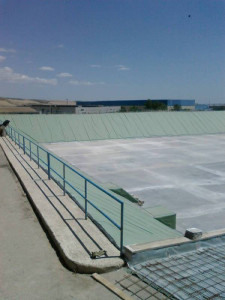The Syntetic Waterproofing Covering of The Future
The TPO membranes and synthetic membranes (polyolefins alloys: polyethylene and polypropylene) are the answer to changing market of waterproofing.
Due to their high resistance to aging, the TPO waterproofing membranes are primarily used for waterproofing of reservoirs, dams, and non-toxic version, used in the protection of the containment tanks for drinking water and liquid foods, as well as fish farms.
They are industrial products with quality more controllable. To color them is optional and they offer, depending on the kind, high chemical stability, almost always high deformability, even in cold : they are more durable, does not require a pose in the double layer and the quality of the process of welding them is more easily to control. Someone is self-adhesive .
- absence of chlorine and other pollutants ;
- absolute compatibility with bitumen ( or products bituminous coals) ;
- weldability with hot air;
- high resistance to aging ;
- chemical inertness of the mantle ;
- total recyclability of the material.
- Differents from PVC
- Stiffer ( less adaptable )
The synthetic TPO waterproofing material is currently used with success in all areas of the roofing industry and civil engineering. In particular, in the roofing industry, using membranes with internal reinforcement in polyester mesh for exposed roofing membranes and mechanically fastened with internal reinforcement glass fiber roofing finish ballasting to fixed or mobile. This armor is also provided for the waterproof coating TPO glued directly to the support but , in this case , during the production phase we proceed to the coupling of a non-woven felt on the lower face of the product to improve the adhesion characteristics.
Can be distinguished two types of products :
The modified polyolefins based polypropylene and polyethylene -based modified polyolefins
A) The modified polyolefins polypropylene -based
Are products that have a certain stiffness ( when compared to those of PVC -P ) but which possess a good resistance to temperature variations , have good tensile strength , high characteristics of flexibility and a life expectancy in work more than 25 years
B) The modified polyolefins polyethylene -based
In this case the product is modified with polymers with low melting point, are more flexible than those which use only polyethylene, but are more sensitive to high temperatures.
The mechanical properties are very good in terms of elongation at break, but less satisfactory speaking of tensile strength.
In the waterproofing of the fund water projects and underground instead are mainly used homogeneous surfaces , that is without the use of any type of armor inside the body of the product. This allows the best use of the characteristic of high elongation at break of their own synthetic turf, so able to ” accommodate ” any rough edges present in the soil in reservoirs and hydraulic basins without incurring breakage that would affect a complete waterproofing and storage capacity of water.
The same feature also becomes crucial in the case of so-called “out of shape” in tunnels, especially in the presence of water under pressure would solicit from behind the waterproofing system of the building, leading to the inevitable breakage that would be capable of compromising the whole waterproofing .
Contact us
Don’t hesitate to contact us for any information about












